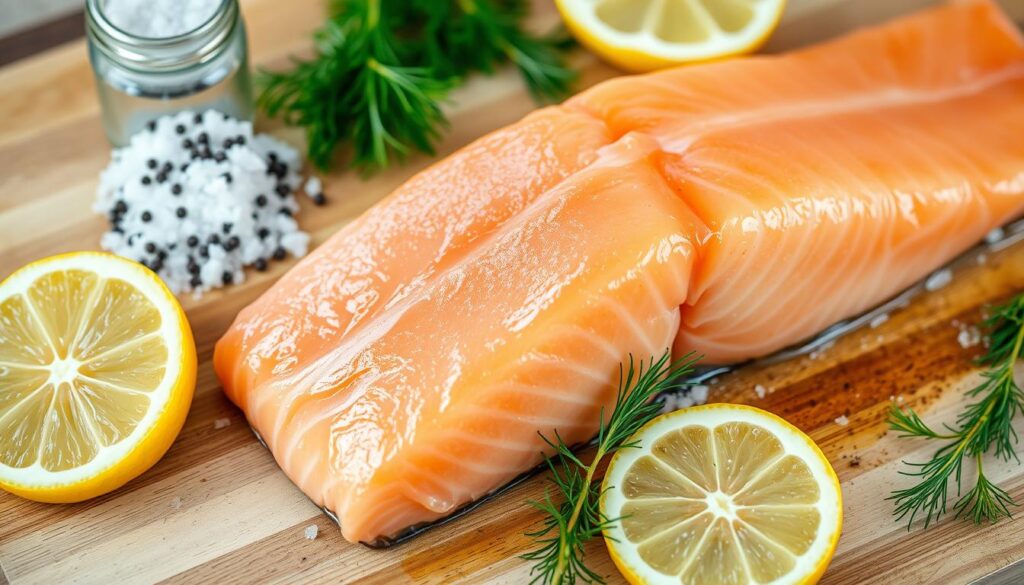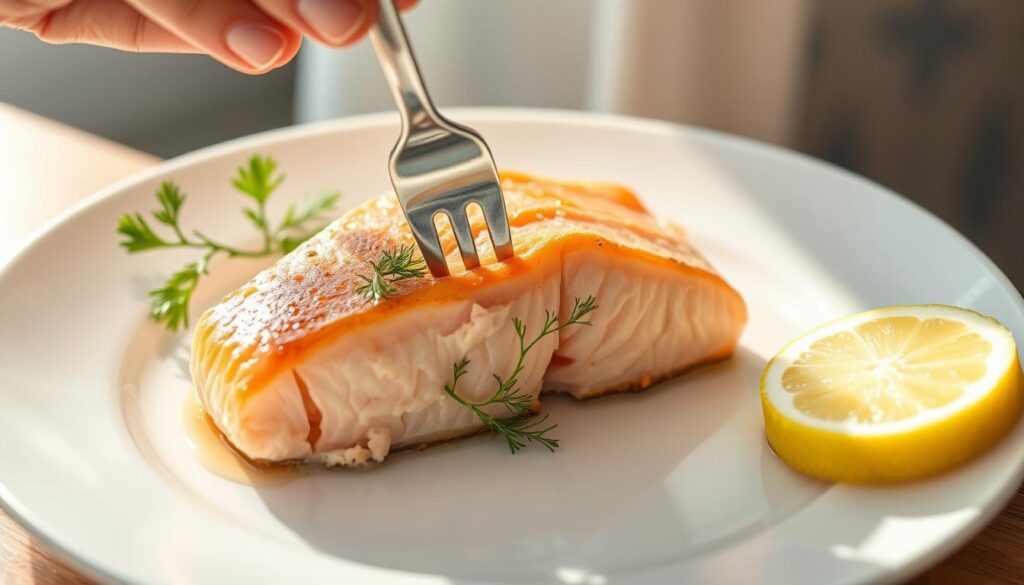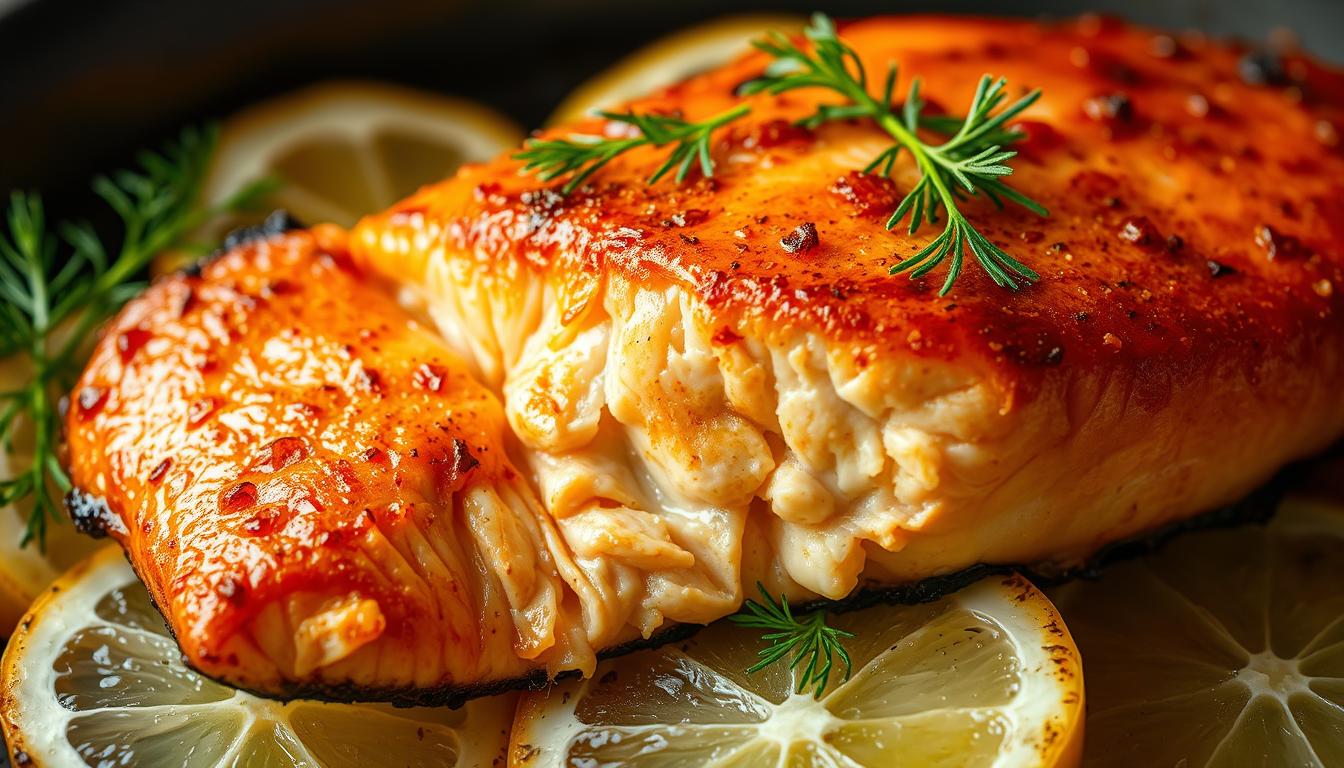How to cook a delicious baked salmon filet.
Every home cook dreams of making a restaurant-quality baked salmon filet. The first time I mastered this recipe, my kitchen filled with an amazing smell. My family couldn’t believe I made such a gourmet meal.
Cooking salmon is not hard, and with the right techniques, you can make it a culinary masterpiece. Salmon recipes have become simpler, making it easy for anyone to cook a great meal.
Baked salmon filet is not only tasty but also healthy, full of omega-3 fatty acids and protein. I want to share the secrets to making a dish that everyone will love.
Table of Contents
Understanding the Perfect Baked Salmon Filet
Salmon is a top pick for healthy seafood lovers. It’s full of flavor and packed with nutrients. It’s also a great choice for those who care about their health.
Finding the right salmon can make your cooking better. It’s important to choose high-quality fish. This will make your meals delicious and good for you.
Benefits of Choosing Salmon for Your Meal
Salmon is great for your health. It has many benefits:
- Rich in omega-3 fatty acids for heart health
- High-quality protein source
- Packed with essential vitamins and minerals
- Low in calories
Quality Selection Tips for Salmon
Here are tips for picking the best salmon:
| Selection Criteria | What to Look For |
|---|---|
| Appearance | Bright, vibrant color with firm flesh |
| Smell | Fresh, mild ocean scent |
| Texture | Smooth, no discoloration or bruising |
Fresh vs. Frozen Salmon Considerations
Deciding between fresh and frozen salmon depends on a few things. Fresh salmon has the best taste. But, frozen salmon is also good and easy to store.
- Fresh salmon: Best when bought from a trusted seafood market
- Frozen salmon: Great for keeping longer and having consistent quality
Pro tip: Always buy salmon from trusted places for the best quality.
Essential Kitchen Tools and Equipment
Preparing a perfect salmon filet needs more than just cooking skills. The right kitchen tools can make your salmon filet preparation stand out. Having the right equipment before you start cooking makes the meal smooth and successful.
For successful salmon filet preparation, you’ll need several key kitchen tools:
- Baking Sheet: A sturdy, high-quality baking sheet provides even heat distribution
- Parchment Paper or Aluminum Foil: Prevents sticking and makes cleanup easier
- Meat Thermometer: Critical for checking salmon’s internal temperature
- Sharp Fillet Knife: Ensures precise cutting and clean preparation
- Cutting Board: Preferably a dedicated board for seafood
Your meat thermometer is especially important in salmon filet preparation. It ensures you cook the salmon to the right temperature. Professional chefs say to aim for an internal temperature of 145°F for perfectly cooked salmon.
Investing in quality tools might seem unnecessary, but they can greatly improve your cooking. A good baking sheet, reliable thermometer, and proper cutting tools make your salmon filet preparation consistent and enjoyable.
Preparing Your Salmon for Baking
Getting your salmon ready for baking is key. The right preparation can turn a simple meal into a feast. How you prepare the fish will affect its taste and texture.
Room Temperature Matters
Let your salmon sit at room temperature for 15-20 minutes before baking. This step ensures it cooks evenly. Cold salmon can cook unevenly, leading to tough spots.
Cleaning and Drying Techniques
Cleaning your salmon is essential. Here’s how to get your filet ready:
- Rinse the salmon under cold water
- Inspect for any remaining scales
- Pat dry thoroughly with paper towels
- Remove any pin bones using clean tweezers
Pro tip: Dry the salmon well for a crispy exterior.
Managing Salmon Skin
Salmon skin can add flavor and texture to your dish. You have two choices:
- Leave the skin on for extra flavor and crispy texture
- Remove the skin before cooking if you prefer
If you choose to keep the skin, make sure it’s clean. Place the filet skin-side down for the best results.
Perfect Temperature and Timing Guide
Cooking moist salmon filets needs precision and care. The right temperature can turn a good meal into a great one.
Here are the key temperature tips for oven-baked salmon:
- Ideal oven temperature: 375°F (190°C)
- Cooking time: 12-15 minutes for standard filets
- Target internal temperature: 125°F to 130°F for medium-rare
The thickness of your salmon is important for cooking time. Thicker filets take longer, while thinner ones cook faster.
| Salmon Fillet Thickness | Recommended Cooking Time | Internal Temperature |
|---|---|---|
| 1/2 inch thick | 8-10 minutes | 125°F |
| 1 inch thick | 12-15 minutes | 130°F |
| 1.5 inches thick | 15-18 minutes | 135°F |
Pro tip: Always use a meat thermometer to check the internal temperature of your oven-baked salmon. This ensures your filets remain juicy and perfectly cooked every time.
Remember, the salmon will keep cooking after it’s out of the oven. Take it out when it’s a bit underdone to avoid overcooking later.
Creating the Perfect Garlic Butter Sauce
Make your salmon dishes even better with a tasty garlic butter sauce. This sauce can turn simple baked salmon into a gourmet delight. It adds a rich flavor to every bite.
Essential Ingredients for Your Sauce
To make the best garlic butter sauce, you need just a few things. These ingredients will make your salmon recipes stand out:
- Unsalted butter (melted)
- Fresh garlic, finely minced
- Fresh lemon juice
- Chopped fresh herbs
Precise Mixing Techniques
The key to a smooth garlic butter sauce is in how you mix it. Whisk your ingredients well to get a perfect blend that goes great with your salmon.
| Ingredient | Quantity | Preparation Tip |
|---|---|---|
| Butter | 1/4 cup | Melt until smooth |
| Garlic | 2-3 cloves | Finely mince |
| Lemon Juice | 1 tablespoon | Fresh-squeezed preferred |
| Fresh Herbs | 1 tablespoon | Chop finely |
Flavor Enhancement Secrets
Want to make your garlic butter sauce even better? Here are some tips:
- Use room temperature butter for smoother blending
- Roast garlic slightly for a deeper flavor profile
- Add a pinch of red pepper flakes for subtle heat
- Finish with fresh chopped parsley for brightness
Pro Tip: Always taste and adjust your sauce before drizzling over your flavorful salmon to ensure perfect seasoning.
How to Season Your Baked Salmon Filet

Turning a simple salmon filet into a flavorful dish starts with the right seasoning. By choosing the perfect herbs and spices, you can make a basic recipe into a masterpiece.
Understanding flavor profiles that match the fish’s natural taste is key. Salt and pepper are a good start, but don’t stop there.
- Classic herb combinations
- Zesty citrus blends
- Spicy Mediterranean styles
- Aromatic Asian-inspired seasonings
Here are some top seasoning strategies for a memorable salmon experience:
| Seasoning Type | Key Ingredients | Flavor Profile |
|---|---|---|
| Mediterranean | Dried oregano, thyme, garlic powder | Herbaceous and bright |
| Cajun | Paprika, cayenne, black pepper | Spicy and bold |
| Asian-Inspired | Ginger, sesame, soy sauce | Umami and complex |
Pro tip: Always pat your salmon dry before applying seasonings to ensure maximum flavor absorption and a perfect crispy exterior.
“The right seasoning can transform a simple salmon filet into a gourmet meal.” – Professional Chef
Try different herb and spice mixes to find your favorite. Fresh herbs like dill, parsley, and chives can add a vibrant touch to your baked salmon.
Step-by-Step Baking Process
Preparing an oven-baked salmon filet needs care and focus. Your journey starts with knowing the key steps of baking.
Learning the baking technique turns your salmon into a dish to remember. Here are the main steps to cook your salmon perfectly every time.
Preheating Your Oven
Getting the oven temperature right is key for a great salmon. Heat your oven to 375°F (190°C). Wait until it’s fully preheated before adding the salmon. This ensures it cooks evenly and keeps its tender texture.
Strategic Pan Placement
The right baking sheet and where you put it matter a lot. Here are some tips:
- Choose a rimmed baking sheet with parchment paper
- Put the salmon in the oven’s center
- Make sure there’s enough space around it for air to move
Monitoring Your Cooking
Keep an eye on your salmon while it’s baking. This helps avoid overcooking and keeps it moist. Look for these signs:
- The salmon should change from clear to opaque
- It should flake easily with a fork
- The internal temperature should hit 145°F (63°C)
Cooking time is usually 12-15 minutes, based on the salmon’s thickness. It’s safer to slightly undercook than overcook your salmon.
Fresh Herbs and Garnishing Options
Adding the right garnish can turn a simple salmon dish into a work of art. Fresh herbs are key in adding depth and beauty to your baked salmon.
Choosing the right herbs can really boost your salmon’s taste. Some top picks include:
- Dill – offers a delicate, slightly tangy taste
- Parsley – provides a fresh, clean flavor
- Chives – adds a mild onion-like brightness
- Cilantro – brings a zesty, vibrant touch
Here are some ways to make your salmon stand out:
- Chop herbs finely for even distribution
- Sprinkle fresh herbs just before serving
- Use lemon wedges for a citrusy accent
Remember, fresh is best when it comes to garnishes. While dried herbs can do, nothing beats the taste of fresh herbs.
| Herb | Flavor Profile | Best Pairing |
|---|---|---|
| Dill | Subtle, Tangy | Baked or Grilled Salmon |
| Parsley | Fresh, Clean | Roasted Salmon Dishes |
| Chives | Mild Onion | Creamy Salmon Preparations |
“The right herb can transform a good salmon recipe into an extraordinary culinary experience.”
Try mixing different herbs to find your favorite garnish. Your salmon recipes will love the extra freshness and beauty.
Testing for Doneness
Getting moist salmon filets just right needs careful attention and the right techniques. Knowing when your salmon is perfectly cooked can turn a meal into a hit or a miss.

Cooking salmon is an art that requires precision. The secret to delicious moist salmon filets is knowing the signs of perfect cooking.
Visual Indicators of Perfectly Cooked Salmon
Here are the key visual signs your oven-baked salmon is done:
- Salmon turns from translucent to opaque pink
- Flesh becomes flaky and separates easily with a fork
- Surface appears slightly glossy and moist
- Edges look slightly crisp but not dried out
Temperature Guidelines for Ideal Doneness
Use a meat thermometer to check the salmon’s internal temperature:
- Medium-rare: 125°F to 130°F
- Medium: 135°F to 140°F
- Well-done: 145°F
Pro tip: Take your salmon out of the oven when it’s 5-10 degrees below your target. The fish will finish cooking with the heat left inside, making it moist every time.
Serving Suggestions and Presentation
To make your fish dishes stand out, focus on presentation and side dishes. Your baked salmon should look as good as it tastes. It’s all about impressing your guests.
Here are some ways to make your salmon look elegant:
- Place the salmon on a bed of roasted seasonal vegetables
- Top it with fresh herbs like dill or parsley
- Include lemon wedges for a burst of citrus
- Pair it with light grains like quinoa or wild rice
Plating can turn your dish into a gourmet meal. Use white plates to highlight the salmon’s color. Place the salmon at an angle and add microgreens for a fancy look.
For a family-style meal, use a big platter with the salmon in the middle. Add sides like roasted asparagus or a Mediterranean salad. It’s not only beautiful but also encourages everyone to share.
Remember, serve your salmon right after cooking to keep it moist. If you must wait, cover it with foil to keep it warm. This way, you won’t lose its tender texture.
Storage and Leftover Management
Keeping your healthy seafood dishes fresh is key. Baked salmon stays tasty and safe with the right storage and reheating. Follow these tips for leftovers.
Refrigeration Best Practices
Proper storage keeps salmon fresh longer. Here’s how to do it right:
- Cool salmon completely before storing
- Use airtight containers to prevent moisture loss
- Store in the refrigerator within two hours of cooking
- Keep refrigerated for up to 3 days maximum
Smart Reheating Methods
Reheating salmon gently is crucial. Here are some good ways to do it:
- Oven method: Preheat to 275°F and warm for 10-15 minutes
- Microwave technique: Use low power and short intervals
- Cold preparation: Use in salads or cold dishes
| Storage Method | Duration | Quality Preservation |
|---|---|---|
| Refrigerator (Airtight Container) | Up to 3 days | Excellent |
| Room Temperature | Less than 2 hours | Not Recommended |
Pro tip: Always trust your senses. If the salmon smells off or looks discolored, it’s best to discard it.
Get creative with leftover salmon. Turn it into new dishes like salads, pasta, or quick lunches.
Conclusion
Making the perfect baked salmon filet is an art. It mixes technique, passion, and creativity in the kitchen. By learning the key steps and trying out different recipes, you can make this healthy seafood into a top-notch meal at home.
Every baked salmon filet is a chance to try new flavors and get better at cooking. You’ve learned how to pick the best fish and bake it just right. This will help you make salmon dishes that wow your loved ones.
Cooking is a never-ending journey. Start with the basics from this guide, but feel free to add your own twist to salmon recipes. As you get better, you’ll find new ways to season, sauce, and garnish your salmon. This will make your dish truly stand out.
Enjoy the journey of cooking and relish the tasty outcomes of your efforts. Your kitchen is ready to turn a simple salmon filet into a memorable meal.

